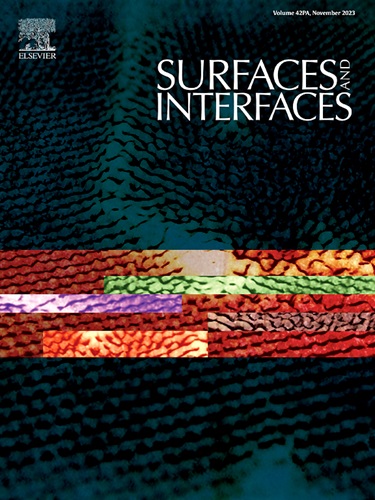Phosphonic acid derivative-driven surface reconstruction: An efficient strategy to overcome lizardite coating contamination in copper sulfide ore flotation
IF 5.7
2区 材料科学
Q2 CHEMISTRY, PHYSICAL
引用次数: 0
Abstract
Surface properties and interfacial interactions are the core mechanisms for regulating foam flotation. Lizardite, a representative magnesium-bearing silicate, serves as the primary contaminant adhering to copper sulfide ore surfaces due to its distinctive surface characteristics. Conventional dispersants for alleviating hetero-coagulation are constrained by the limitations: high operational costs, suboptimal efficiency, and environmental pollution. In this study, diethylenetriamine pentamethylene phosphonic acid (DTPMP), a novel highly effective scale inhibitor with demonstrated superior performance in recent studies, was innovatively employed to address the challenge of lizardite coating adhesion on chalcopyrite surfaces. Flotation experiments revealed that DTPMP significantly enhanced chalcopyrite-lizardite separation across a broad pH range. A high-quality copper concentrate with a recovery of 93.07 % and copper grade of 30.92 % was obtained in natural pH conditions with a DTPMP concentration of 60 mg/L. Through SEM-EDS morphology, DRIFT spectroscopy, UV–Vis spectroscopy, zeta potential, ICP-OES, and solution chemistry analyses, DTPMP was found to selectively adsorb onto the lizardite surface. Complexation facilitated the dissolution of lizardite surfaces, markedly increasing their negative charge density. This process induced electrostatic repulsion between lizardite and chalcopyrite, eliminating hetero-aggregation, as supported by DLVO theory. As a lizardite depressant, DTPMP also activated PAX adsorption on chalcopyrite surfaces. XPS and DFT analyses confirmed that multiple phosphonic acid groups in DTPMP exhibited strong nucleophilic reactivity. Oxygen anions in these functional groups spontaneously formed stable ionic bonds with exposed Mg ions on lizardite surfaces, enabling chemical adsorption. The high efficiency of DTPMP highlights its enormous potential for purifying chalcopyrite from magnesium-bearing silicate.
膦酸衍生物驱动的表面重建:克服硫化铜矿浮选中蜥蜴石涂层污染的有效策略
表面性质和界面相互作用是调控泡沫浮选的核心机制。lilizardite是一种典型的含镁硅酸盐,由于其独特的表面特征,它是附着在硫化铜矿石表面的主要污染物。用于缓解异混凝的传统分散剂受到操作成本高、效率欠佳和环境污染等限制。在这项研究中,二乙烯三胺五亚甲基膦酸(DTPMP)是一种新型高效阻垢剂,在最近的研究中表现出优异的性能,被创新地用于解决黄铜矿表面上lizardite涂层粘附的挑战。浮选实验表明,DTPMP在较宽的pH范围内显著提高了黄铜矿与蜥蜴石的分离。在自然pH条件下,DTPMP浓度为60 mg/L,可获得铜回收率为93.07%,铜品位为30.92%的高质量铜精矿。通过SEM-EDS形貌、DRIFT光谱、UV-Vis光谱、zeta电位、ICP-OES和溶液化学分析,发现DTPMP在蜥蜴石表面有选择性吸附。络合促进了蜥蜴石表面的溶解,显著增加了它们的负电荷密度。这个过程引起了蜥蜴石和黄铜矿之间的静电排斥,消除了异质聚集,DLVO理论支持。作为蜥蜴石抑制剂,DTPMP还能激活PAX在黄铜矿表面的吸附。XPS和DFT分析证实,DTPMP中多个磷酸基团表现出较强的亲核反应性。这些官能团中的氧阴离子自发地与暴露在蜥蜴石表面的Mg离子形成稳定的离子键,从而实现化学吸附。DTPMP在含镁硅酸盐中提纯黄铜矿方面具有巨大的潜力。
本文章由计算机程序翻译,如有差异,请以英文原文为准。
求助全文
约1分钟内获得全文
求助全文
来源期刊

Surfaces and Interfaces
Chemistry-General Chemistry
CiteScore
8.50
自引率
6.50%
发文量
753
审稿时长
35 days
期刊介绍:
The aim of the journal is to provide a respectful outlet for ''sound science'' papers in all research areas on surfaces and interfaces. We define sound science papers as papers that describe new and well-executed research, but that do not necessarily provide brand new insights or are merely a description of research results.
Surfaces and Interfaces publishes research papers in all fields of surface science which may not always find the right home on first submission to our Elsevier sister journals (Applied Surface, Surface and Coatings Technology, Thin Solid Films)
 求助内容:
求助内容: 应助结果提醒方式:
应助结果提醒方式:


